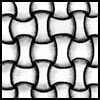 Huggins is a Zentangle®-original tangle pattern from co-founders Rick Roberts and Maria Thomas.
Huggins is a Zentangle®-original tangle pattern from co-founders Rick Roberts and Maria Thomas.
It is one of several tangles resembling weaving that are great fun to draw.
A variant of Huggins is W2 (Warp and Weft), drawn using squares instead of the dots of the first step, connected with straight lines instead of curved ones.
CZT Vicki Murray’s site with the instructions for drawing Huggins no longer exists. For your convenience, here is my illustration of the steps.
When you draw your initial dots in Step 1 larger than what I’ve shown here, it creates a more open weave. Shading adds the final touch to achieve the 3D woven effect.
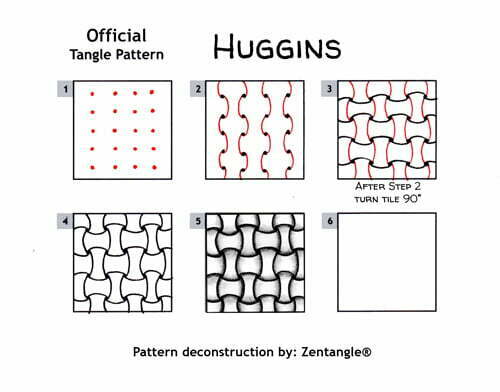
Image copyright the artist and used with permission, ALL RIGHTS RESERVED. Please feel free to refer to the step outs to recreate this tangle in your Zentangles and ZIAs, or link back to this page. However the artist and TanglePatterns.com reserve all rights to these images and they should not be pinned, reproduced or republished. Thank you for respecting these rights.
UPDATE December 15, 2016 – In a blog post for the last day of their “12 Days of 3Zs”, Rick and Maria post the steps to another way of tangling Huggins they’ve named Crazy Huggins.
UPDATE November 11, 2017 – Project Pack #01. In this this video (28:14) Molly demonstrates Crazy Huggins using White Sakura Gelly Roll Pens on a black Apprentice Zentangle tile. She includes the tangles Shattuck and Crazy ‘Nzeppel to fill the Huggins shapes.
UPDATE December 8, 2018 – Project Pack #04. As part of the Twelve Days of Zentangle, 2018 Edition series, in this Day 6 video starting at (14:33) Maria’s daughter CZT Martha Huggins demonstrates how to tangle and shade her namesake Huggins.
.oOo.
UPDATE July 22, 2020 – Project Pack #10. As part of The Legend of Zentangle project pack series, Julie Willand demonstrates how to tangle Crazy Huggins at 17:04.
.oOo.
UPDATE July 24, 2020 – Project Pack #10. As part of The Legend of Zentangle project pack series, Martha tangles Huggins at 46:46.
.oOo.
UPDATE July 26, 2020 – Project Pack #10. As part of The Legend of Zentangle project pack series, starting at 02:14 Maria shows her tile combining Doodah, Mooka, and Huggins.
.oOo.
UPDATE December 12, 2020 – Project Pack #12. As part of the 12 Days of Zentangle, 2020 Zentangle Renaissance project pack, Martha tangles Huggins on a Renaissance tan tile.
.oOo.
UPDATE December 13, 2021 – Project Pack #16. As part of the 12 Days of Zentangle – Keeping Score project pack, Julie tangles Crazy Huggins on a square white Zentangle tile.
.oOo.
UPDATE December 14, 2022 – Project Pack #19. As part of the Twelve Days of Zentangle, 2022 Edition project pack, Rick tangles Cadent and Huggins in this video:
.oOo.
UPDATE May 20, 2023 – As part of Zentangle’s 21-day challenge honoring May’s Mental Health Awareness month, Day 10’s Bijouism is Reflect and Rick tangles Huggins in this 16:30 minute limited-audio video.
.oOo
UPDATE March 17, 2024 – Project Pack #23. As part of the Birth of the Zentangle Method project pack, Martha tangles Funls (aka “Puppy Huggins”) in the Day 2 video shown here.
.oOo.
UPDATE May 16, 2025 – As part of Zentangle’s 2025 Mental Health Awareness Month Challenge, Rick tangles Huggins in this video:
.oOo.
UPDATE July 15, 2025 – In celebration of International Day of Zentangle (IDOZ) in a live stream fundraising event with 1,552 participants, Rick and Maria tangle Spoken Huggins on a tan Zendala tile. Using the beginning orb and spokes of Spoken, they grow Huggins in a radial fashion.
In the video Maria talks about the “tangle of the year” and its versatility. One “hugg” is a fragment, “many huggs hugging” creates Huggins, it can be used as a reticula, it can provide texture and it has so many potential fun fills.
.oOo.
UPDATE December 7, 2025 – Project Pack #28. As part of the Twelve Days of Zentangle – 2025 Edition – Inspired by Leonardo da Vinci project pack, Julie tangles Crazy Huggins and Diva Dance in this video:
.oOo.
Check out the tag zentangle for more Zentangle®-original tangles on TanglePatterns.com.
For a complete list of Zentangle’s Project Packs click the PROJECT PACKS link in the pink alphabetic tangle menu bar.
Related Links
- Looking for tangles by Artist or Type? For details visit the ABOUT > HOW TO FIND TANGLES BY ARTIST OR TYPE page on the top menu bar of any page on the site.
- What is a Zentangle? — if you are new to the Zentangle Method, start here for the fundamentals.
- Zentangle terminology — a glossary of terms used in this art form.
- How to use the site — an excellent free video tutorial showing how to use the site as well as pointing out lots of useful features you might have missed.
- Linda's List of Zentangle-Original Patterns — here is the complete list of original tangles (aka "official tangles") created and introduced by founders Rick Roberts and Maria Thomas, including those not published online. If you are new to the Zentangle Method I highly recommend learning a few of the published Zentangle classics first.
- "A Zentangle has no up or down and is not a picture of something, so you have no worries about whether you can draw a hand, or a duck. You always succeed in creating a Zentangle." Patterns that are drawings of a recognizable naturalistic or actual object, figure, or scene, are not tangles. A pattern is not always a tangle — here's what makes a tangle. TIP: tangles never start with pencil planning.
- Un motif n’est pas toujours un tangle — Qu’est-ce qu’un tangle ?
- Un diseño no es siempre un tangle — ¿Qué es un tangle?
- How to submit your pattern deconstruction to TanglePatterns
- For lots of great FREE tutorials on TanglePatterns, click on the TUTORIALS link in the pink alphabetic menu bar below the tangle images at the top of any page.
- Strings! Have we got STRINGS! Click on the STRINGS link in the pink alphabetic menu bar below the tangle images at the top of any page for 250 different (free) Zentangle-starters. More than enough for any lifetime!
- Never miss a tangle! FREE eMAIL NEWSLETTER - visit the Here's how to SUBSCRIBE button (top of left sidebar on any page) and sign up to get notices delivered free to your inbox.
- If you have questions about the TanglePatterns.com TANGLE GUIDE, visit the BOOK REVIEWS tab on the top menu bar of any page on the site for COMPLETE details!
|
.oOo. |
|
Enhance your Zentangle experience while supporting TanglePatterns: |
|
2025 EDITION! (2026 COMING SOON) TanglePatterns.com TANGLE GUIDE, 2025 Edition |
|
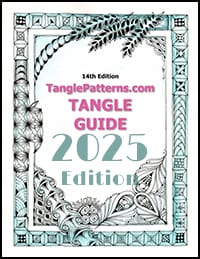 |
The 14th Edition of the TanglePatterns.com TANGLE GUIDE is an instant-download 117-page interactive digital eBook/PDF containing over 2,000 tangles on the site from May 2010 through December 31, 2024. It's a great resource and a must-have digital tool for using the site. Visit the STORE > E-BOOKS page and help keep TanglePatterns.com going by getting your copy now! |
|
"Linda, Thank you! I was relying on too few and getting stuck after 3 years of daily working with Zentangle. This has inspired me to ‘begin again’ with renewed excitement." ~ Barbara R. |
|
| See the BOOK REVIEWS page for more details on its features and view a sample page. Note: this is a digital product you download immediately when you place your order, nothing will be physically mailed to you. | |
| If you're new to Zentangle® and tangling, my TanglePatterns.com BEGINNER'S GUIDE TO ZENTANGLE is just what you need to get started. Also available en Français and en Español. | |
|
|
|
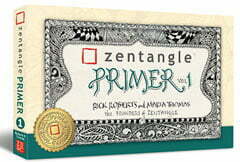 |
This is the only Zentangle book you'll ever need: the fabulous Zentangle PRIMER Vol 1. It's your CZT-in-a-book by the founders of Zentangle®. Visit the STORE tab on the top menu bar or click on the image. For more about the content and to read the rave reviews, visit the BOOK REVIEWS tab. |
| Now available in KINDLE format for $9.99. Spanish Edition here. Japanese Edition here. | |
| "Absolutely the best Zentangle Book yet! As an accomplished artist I used to think I did not need instruction on this art form. How wrong I was! My tangling improved by leaps and bounds after reading this book. If you think you have Zentangle down then you need this book more than ever!" ~ Kris H | |
|
|
|
|
.oOo. |
|

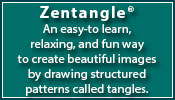


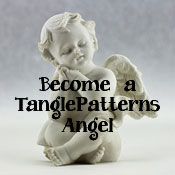

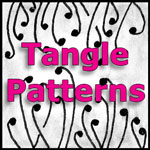
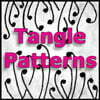
I struggled with W2 and I mean struggled. But after I “got” Huggins, I was able to do W2. I have to hand it to Vicki: she is the one who revealed the mystery of weaving and Shattuck to me. Hooray for Vicki!
Neither Vicki nor Suzanne McNeill (who gives steps for W2) give explicit instructions for beginning the “down” connection. And it took me a while before I realized it is a simple formula. In case it helps anybody, think of the horizontal line connectors as marching up, down, up, down, the up and down being relative to the squares or circles they are joining. Adjacent lines mirror this alternating connection. So, two horizontal rows would read
1. up, down, up, down, up, down
2. down, up, down, up, down, up
When you go to start the vertical connections, the pattern is inside, outside, inside, outside relative to the circles or squares. And the trick is, if the horizontal connector is up, the vertical connector is inside. Carry on the pattern from there. If the horizontal connector is down, the vertical connector is outside. This works at any point in the pattern (good to know for continuing the pattern in odd little nooks and crannies).
That looks TERRIFYING in print because it takes so long to explain but you can readily “see” it with just a couple of lines of example and prove it to yourself.
P.S. If you start off the vertical incorrectly, you might just want to carry on because the resulting variant is actually quite pleasing.
Thanks for sharing, Kim. I’m sure it will help out a lot of folks. This is definitely one of those patterns that requires total concentration.
I try and I try but I can not get this down:/
For many tangle patterns, one of the “secrets” is to be sure to turn your tile as you work.
So with this one, try doing all the horizontal lines first – Kim’s “up, down” tip helps with that.
Then turn the tile 90 degrees, and you’ve got horizontal lines to deal with again. It does require your full deliberate attention to each stroke.
Hope this helps! Keep trying, once you get it the “ah hah” moment is worth it.
Sorry to hear of your troubles. I assure you I had reams of pages of mangled Huggins before it finally clicked for me.
I have just read my post above and it reads like gobbledy gook so I won’t refer you to it but I can tell you that this is one of those ones you really have to deconstruct in your own mind–it had to “click” for me before I could do it, I couldn’t even just imitate it.
good luck!!!!!! Please let us know if you crack it.
this pattern need a lot of concentration and i need a lot of help
It definitely requires focus – have patience and you will get it.
I also had a horrible time with this one, and it finally clicked after trying many, many, many times.
Update 12/15/2016: In a blog post for last day of their “12 Days of 3Zs”, Rick and Maria post the steps to another way of tangling Huggins they’ve named Crazy Huggins.
In Zentangle’s “21 Days of Bijouisms” series honoring Mental Health Awareness Month, today’s bijouism is Reflect and today’s tangle is Huggins.